Aetiological
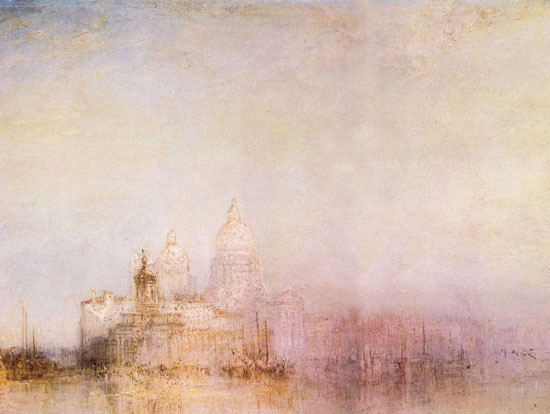
—piecemeal—
– The Dogana and Santa Maria della Salute, Venice, Joseph Mallord Turner
The Ideal City is, like any city, built piecemeal.
People drift together, interact, multiply; build hospitals, cathedrals, forums; become cities. So we have Norbiton or Florence or Rome.
From time to time, however, this matter undergoes a accelerative transformation, and a city momentarily emerges from the jumble of settlement: the empirically real mass of Rome becomes Republican Rome, Florence translates itself into Renaissance Florence, Norbiton into Norbiton: Ideal City.
This transformation can only be perceived retrospectively, however. At the time, all we see is the steady drip of a process—a workshop tradition, the practice of clerks or accountants or bureaucrats, the philological rigour of humanists, the experimentation of scientists. This saturating routine of civilisation is the sort of context which will be partly lost and partly shaped—or in other words, transformed—by the subsequent framing of a myth.
Both the observational conundrums of quantum mechanics and the structure of many creation myths teach us that annunciation and conception occur simultaneously. In the same way, the Ideal City decoheres only when it is perceived to exist, or to have existed; the crystallisation of a myth is a moment of generative clarity.
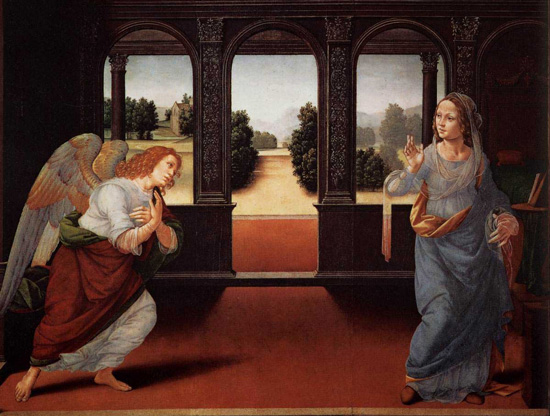
—generative clarity—
– Annunciation, Lorenzo di Credi
![]()
Aetiology is the study of origins, or the study of the myths of origins. Origins of a disease, of a pathology, or of a city or a nation. Vectors, pathogens, Romulus and Remus. If we do not know where we started, how can we know where we are, or how to proceed? If we do not know what is killing us, how can we, in the words of Hunter Sidney, make sense of our death?
What we do not know, cannot trace, we invent. Foundation myths are commonplace. The Romans talked of Romulus and Remus, or, when they needed something a little grander, of Aeneas; the Florentines of the quattrocento talked of their origins in Republican Rome, distancing themselves from Emperors and Popes (but not wealthy oligarchs); and so on. Perhaps the inhabitants of Welwyn Garden City talk of Ebenezer Howard, of the cosmic balance he established between insane asylum and epileptic farm; and the occupants of the Cambridge Estate in Norbiton look out over the rooftops and talk of Le Corbusier, of their post-blitz exile from the East End (did the Etruscans come from Lydia? Did the Cambridge Estate people come from Plaistow?). Who knows?
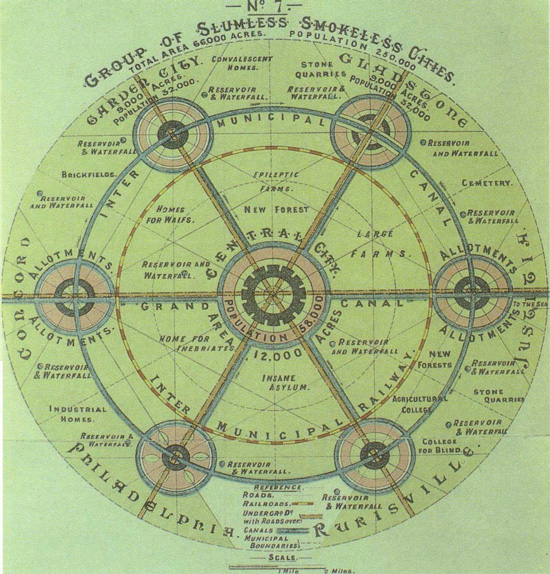
—cosmic balance—
– Garden City, Ebenezer Howard
![]()
So it is that many stories are told about the origins of the Ideal City. Norbiton is a complex object and has a correspondingly rich and complicated historiography.
But nestling among those stories is one which relates how, many months after the inception of the projects one of our associates, a woman I call Mrs Isobel Easter, observed that, like her husband, who twenty years previously had emerged from his private world for a brief spell, and had engaged in a (Failed) Great Public Work; so too were we, the Ideal Citizens of what it pleased her to call the Idle City, much like blinded Cyclopes groping out of our caves, attempting in our turn a cockeyed Great Public Work—the foundation of a City, no less.
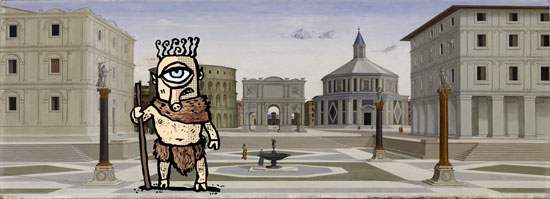
—no hurling of stones—
This, I suppose, was our Annunciation. A woman in a garden, confirming our existence for us by referencing a myth of her own.
![]()
A foundation myth, we have agreed, proposes a moment in which a city takes form; when all that matter of people and energy and restlessness become something charged and notable.
In the centre of Norbiton, then, lying just off the Kingston Road and abutting the football ground are the Kingston Road Allotments. It was here that I met Clarke, and in that meeting, although we hardly knew it at the time, the Ideal City sparked into life.
Ours is not the first city to have emerged from the mud, from a wattle-and-daub prehistory. Venice, summit of light and air, grew up in the reedy, marshy lagoon, its people fleeing the incursions of the Lombards in the sixth century. They must have been miserable for years and centuries, squelching about in the half-land. Un-civilised Roman detritus. Potsherds of humanity.
Like the Norbiton allotments, however, it was a defensible spot. Better here than Milan, Ravenna, Rome. It was a good time to stand on the edge, wait for the dust of empires to settle.
Even when they had grown rich, had built an empire of their own, had become one of the great powers in Italy, the Venetians looked with suspicion on the mainland and were prohibited from owning land there.
There are no such prohibitions in Norbiton. No prohibitions at all. But the Ideal City intersects only obliquely with the empirically real city; our Empire, like the Venetians', is elsewhere; our backs are similarly turned.
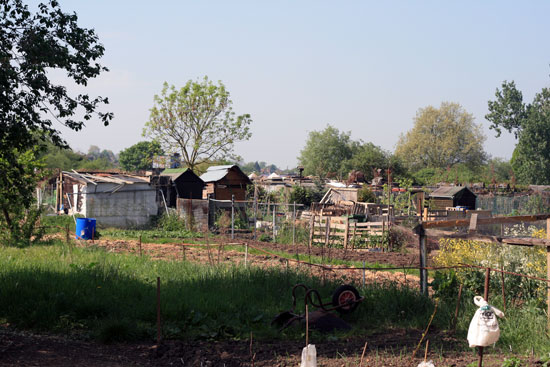
—stand on the edge—
...wait for the dust of empires to settle
![]()
Norbiton: Ideal City may be the first city of the Failed Life, but it is not the first city of failures.
In Book 5 of the Aeneid, Aeneas, short of ships and on a mission from the gods, rids himself of the weak members of his crew and founds them a city, called Acesta, modern day Segesta. Dryden translates the rationale as follows (Aeneas is receiving advice from one of his crew, Nautes):
Your Friend Acestes is of Trojan Kind,
To him disclose the Secrets of your Mind:
Trust in his Hands your old and useless Train,
Too num'rous for the Ships which yet remain:
The feeble, old, indulgent of their Ease,
The Dames who dread the Dangers of the Seas,
With all the dastard Crew, who dare not stand
The shock of Battle with your Foes by Land;
Here you may build a common Town for all;
And from Acestes name, Acesta call.
932-941 book 5
Building a city for the old and useless train meant little more than performing the relevant rituals, mumbo-jumbo said over the baking soil, a ceremony of ploughs and livers, the work of a morning if that.
By and large I am fond of ritual, and one of my first proposals to Norbiton's own dastard crew was that we endorse our City with a similar ceremony.
No one has a plough (Clarke suggested stealing an excavator), and no one was up for slaughtering lambs or goats and reading their livers, but we needed, I felt, a circumference and a mundus; so we decided to walk once around Norbiton and finish in the Albert (not strictly in Norbiton, but we don’t want to be too precious about this) for a plate of their liver and bacon, and then perhaps to our mundus, the allotments, to dig a sacrificial pit of some kind. And have another drink.
That's not exactly how it worked out [for a fuller account of the circumambulation, see here] but when, on a mid-week morning, a Wednesday, we met at the station and watched the commuters shamble on to their trains and leave us to our work, it was like standing on the shore, waving Aeneas off on his deranged mission to conquer Italy and extirpate its natives and found Rome, stone by bloody stone.
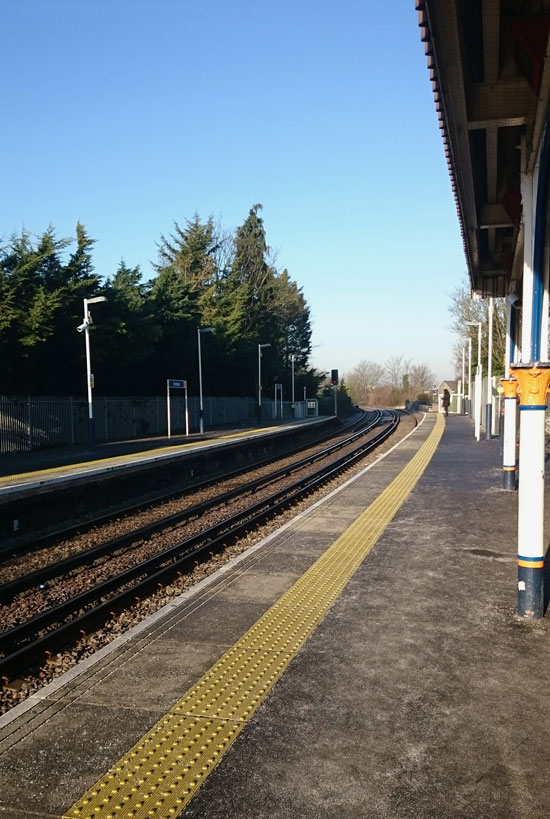
—waving Aeneas off—
...on his deranged mission
![]()
Creation myths and foundation myths—myths, in fact, of any sort—have the demerit of simplicity. Putting things straight in a space which is curved is a form of lying.
But it is a powerful and important form. As your arguments, your histories become more exact, more equivocal, they become also less dense, more diffuse; they lose conviction, power.
We should, however, distinguish between things which are important because a want of them is damaging (oxygen, food) and things which are important merely because they are there (a coffee table in the living room of a blind man). The second sort of important means you have to account for something. Navigate by it or around it. It can be a point on a periplus—personal, tribal, civic—or a rocky promontory you need to know about.
Your personal failure is important because it is there. It should not be ignored. But to mythologise it or its origins, as others mythologise their success, is to make of it a fetish, a psychic crutch.
![]()
In the hands of historians foundation myths become structural rather than merely chronological or purely mythical, in the same way that the etiology of diseases in structural rather than merely sequential.
In the summer of 1402 Florence lay at the mercy of the terrible Giangaleazzo Visconti, Duke of Milan. A series of short wars through the 1390s had seen Florence’s various allies against the aggrandizing Visconti change allegiance, and by 1402 their only ally of any consequence was Bologna. On 26th June Florentine and Bolognese forces were routed at the battle of Casalecchio, and Bologna capitulated days later. All that stood between Visconti and Florentine submission was a weakness he evinced for dilatory triumph. Florence prepared for a siege, pitchforks against steel.
On 26th September word came that Giangaleazzo was dead of plague. By the beginning of the following year his empire was crumbling and the threat gone.
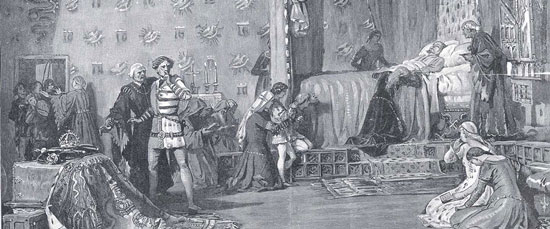
—dead of the plague—
– The Death of Giangaleazzo Visconti, engraving after Lodovico Pogliaghi
That hair's-breadth escape marked a moment of acceleration, a quickening of Florentine self-consciousness. Henceforth Florence would identify itself with Republican Rome. It would carry—in its own eyes, had always carried—the candle of liberty against the long night of imperial or papal or foreign tyranny.
Cities, like the lives of their citizens, change not by smooth progression, but in discrete, lurching, asymmetrical packets of time. Like a doctor running his hand over a broken limb, the aetiologist can sense the ruptures and fault lines buried deep in the flesh of events. But unlike a doctor, more like a quantum mechanic, the aetiologist is also factive—observing the historical moment collapses the wave function of particular events into something manageable, a knot on the string, a promontory on your coastal navigation.
![]()
Cast your mental eye over the smooth chronology of your life, and you will similarly mark patterns, eddies, local coherence.
You do not live on a point between some equidistant past and future, each with its diminishing power corresponding (in inverse proportion) to its distance from you; you occupy a cell of time, a phase, a period with its own internal consistency. This cell might be characterised by a job you do, or a place you live in, or people you frequent; at any one time you will occupy overlapping and superimposed cells, and the force of all experience in that cell will be governed by the gravitational pull not only of that cell but of cells at higher levels of organisation, or of adjacent cells: in any case, there is a local, temporary, if complex and delicate, logic.
Take a step back and you will see that those patterns, those cells in themselves have an orientation. The patterns are complex, certainly, there is a lot of noise (events, detail, hope, ambition, stupidity); there are local clusters that are hard to read; but if you are honest you will see and accept that they do not all answer to your present or your future, but are governed by some moment in your past—your Furthest South, the limits of your journey out into the world.
What do you find at the end of the world? At the end of the world you find marvels, monsters, the road to Hades, something extraordinary. And you spend the rest of your life digesting it, trying to make sense of it, regretting it.
Your Furthest South is where you discover that your paradigms of the possible were wrong. You thought you knew what you wanted from life, you thought you understood where the limits of life were; but something, some moment, some peculiarly rich cell of time, shows you—either generally or specifically—that you had miscalculated, and will have to recalibrate.
And yet we pass it by without noticing. Your Furthest South exerts a gravitational pull on the rest of your life, but gravity, while persistent, is weak. We are attached to the forward drift of events, and will always hope that at our backs is another blazing sun, dragging us into its unexpected and compelling orbit; that what was in fact our Furthest South was only a foretaste of the riches of existence that await us.
And while it may seem paradoxical that, for some of your life at least, you flow towards your origins rather than away from them, the paradox is resolved by the simple observation that the Furthest South is not in fact the beginning of anything. It lies at the end of something, it is a culmination. But everything, that which comes before as much as that which comes after, will be controlled by it, will indicate its singular presence at the heart of everything.
![]()
At the end of the Florentine century, in 1494, Charles VIII of France, pursuing some tenuous antique claim to the throne of Naples, trudged his medieval army with its admittedly impressive artillery train down through the mud of Italy; and, finding his enemies divided, casually subjugated as he went. Until, in February 1495, having barely fought a battle, he ousted the new King Alfonso from his kingdom and took possession of Naples, and of the great Renaissance villa of Poggio Reale. Poggio Reale was to be his Furthest South.
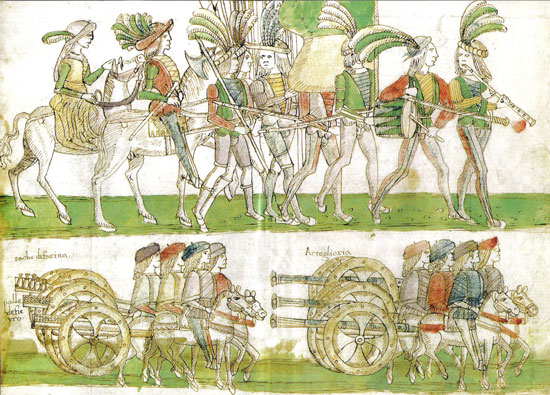
—French troops of Charles VIII entering Naples, 22nd February, 1495—
– from Manuscript MS 801, Pierpoint Morgan Library manuscripts collection; the Italian inscriptions read sache de farina (flour sacks), Artegliaria (artillery), palle de fierro (iron cannonballs)
The villa had been the fruit of an extraordinary visit paid by Lorenzo de’Medici il Magnifico to Alfonso’s father Ferrante in 1480 in pursuit of peace in a different war. This was the discourse of Renaissance princes: having secured the peace after ten weeks of negotiation, Lorenzo undertook to dispatch his most celebrated architect, Giuliano da Maiano, to Naples to build a villa to match his own luminous Poggio a Caiano.
The villa flew up in a matter of years. Both Poggio Reale and Poggio a Caiano were models of grace and proportion, arcaded with slender columns and looking outward, out over their gardens and parks as a mind might reside in and order its sensorium.
Ferrante's, to be sure, was a Renaissance mind not without its dark corners. Burkhardt relates how he liked to keep his enemies close at hand, "either alive in well-guarded prisons, or dead and embalmed, dressed in the costume which they wore in their lifetime". But then Lorenzo was not without his taste for Eastern opulence; one of the features of his villa at Poggio a Caiano of which he was most proud was its menagerie with its parrots and apes and giraffes, a gift in large part of the Sultan of Babylon who, whatever his ignorance of the Classical sensibilities now motivating the greatest Italian princes, was nevertheless assured enough a diplomat to recognise that every de facto prince will relish a little gratuitous exotica.
Charles, to judge from his breathless correspondence, was staggered. Dwarfish, illiterate, bursting with unmanageable boyish ambitions, at his back the dark stone inward-looking castles of France, he stood and stared slack-jawed at Poggio Reale, the perfection of its hydraulics, the shrubs in perpetual flower, the clear-scented immensity of its lemon groves, the whiteness and appropriateness of its alabasters and marbles. This was a beauty he had never conceived possible, reflecting the Albertian virtues of copia et ordo, fruit of a controlling intellect.
On his return to France—kicked out the way he had come by the Pope and the Venetians and the Milanese, finally shaking themselves to some purpose—he took with him, among his spoils, cuttings from the citrus groves for an orangery at Amboise and a gardener (Pasella da Mercigliano). (Alfonso, for his part, when he had been chased from his kingdom was reputed to have fled with seeds and cuttings from his garden).
Historians have looked at Charles’s progress through Italy as, among other things, a reorganisation of European affairs, a triumph of the iron cannonball, and an end of Florentine cultural hegemony (the centre of gravity of the Renaissance would now shift definitively to the Rome of the Imperial Popes); but for Charles personally, sitting in his damp castle in Amboise, cut off from his southern kingdom forever, he had established his Furthest South both literally and figuratively; he would, for the remaining two years of his life, live with a newly attuned sensibility—a new, dimly-remembered, sense of the possible.
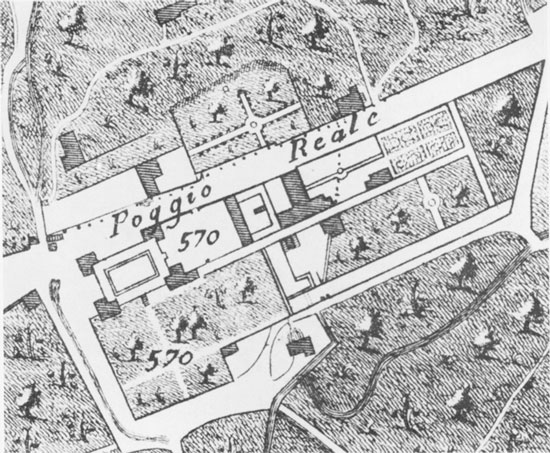
—sense of the possible—
– dimly remembered
![]()
Montaigne, in the essay On Idleness (I:8), provides an aetiology for his book. He had retired, he says, from public life to the lapidary enclosure of his library, the better to think and the better, therefore, to live; but he found that with leisure his mind took to wandering, to throwing up chimeras of the imagination.
His response, after no little torment, was to begin to write them down. To state something clearly in words is to shine a light, he believed, into the dark places, force the ghosts either to declare themselves or disappear.
Thus Montaigne is not building arguments; he is assembling psychic objects, laying them out, noting them, collecting them, like Humboldt botanising the Americas.
Equally a city, like the stuff of Montaigne’s world, is not an argument. An argument is hierarchical, hypotactical; cities, like the Essais, are structurally flat, paratactic, one element bristling up against another.
Montaigne’s problem, then, becomes one of appropriately organising what might otherwise become a hypervarious proliferation. So too our problem, in founding the Ideal City, becomes one of decorously arranging its competing elements. The anatomy, in its ramshackle imperfection, is our first answer to this problem.
![]()
"Recently I retired to my estates, determined to devote myself as far as I could to spending what little life I have left quietly and privately; it seemed to me then that the greatest favour I could do for my mind was to leave it in total idleness, caring for itself, concerned only with itself, calmly thinking of itself. I hoped it could do that more easily from then on, since with the passage of time it had grown mature and put on weight.
But I find —
Variam semper dant otia mentis
[Idleness always produces fickle changes of mind]
– Lucan, Pharsalia, IV, 704— that on the contrary it bolted off like a runaway horse, taking far more trouble over itself than it ever did over anyone else; it gives birth to so many chimeras and fantastic monstrosities, one after another, without order or fitness, that, so as to contemplate at my ease their oddness and their strangeness, I began to keep a record of them, hoping in time to make my mind ashamed of itself."
Montaigne, Essais I:8, on idleness, trans. M.A. Screech
![]()
The search for origins is thus not a search for meaning, but a search for constraints on the proliferation of meaning. We suppose that if the beginning was here, then it cannot also have been there, and in the process we felicitously lop off whole branches of enquiry.
An aetiological myth is in other words a charter for dereliction; it is through dereliction that we retrieve form from the formless. This is, after all, how stories work. The discovery of mythic origins, according to this account, is a pragmatic incantation or lullaby, a Hunting of the Snark; a way of appeasing the ancestors, settling the ghosts.
But it is a pragmatism fuelled by the illusion that in locating accurate origins we will simultaneously ground ourselves upon true understanding. While hunting back up the course of the river may be a salutary process, it will not reveal a crystal spring in the mountains of the moon. Or rather, it will reveal that crystal spring to be mythic.
No. We drive the ever-sickening explorers of our divided souls towards quagmires; invisible, extensive, ill-defined marshland, tailing into bogginess, into the damp; where they stand, squelching their boots, scratching their heads, conscious not of the ecstatic epiphany of discovery and validation, but only of an unlocalisable rheumatic ache.

—ache—
